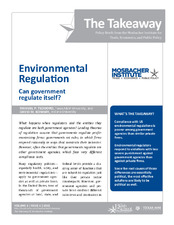| dc.creator | Teodoro, Manuel P. | |
| dc.creator | Konisky, David M. | |
| dc.date.accessioned | 2016-01-26T21:24:21Z | |
| dc.date.available | 2016-01-26T21:24:21Z | |
| dc.date.issued | 2015-10 | |
| dc.identifier.uri | https://hdl.handle.net/1969.1/156046 | |
| dc.description.abstract | Leading theories of regulation assume that governments regulate profit-maximizing firms: governments set rules, to which firms respond rationally in ways that constrain their behavior. However, often the entities that governments regulate are other government agencies, which face very different compliance costs. US environmental policy provides an ideal example to illustrate differences in public and private regulation outcomes because public agencies and private firms provide similar services, confront similar regulatory obligations, and are sufficiently numerous to provide statistical traction. The authors studied two prominent US environmental programs, the Clean Air Act (CAA) and the Safe Drinking Water Act (SDWA), and found evidence that publicly-owned facilities are more likely than similar privately-owned facilities to violate regulatory requirements under the CAA and SDWA. | en |
| dc.language.iso | en_US | |
| dc.publisher | Mosbacher Institute for Trade, Economics & Public Policy | |
| dc.relation.ispartofseries | Volume 6;Issue 6 | |
| dc.subject | Environmental Protection Agency (EPA) | en |
| dc.subject | Clean Air Act (CAA) | en |
| dc.subject | Safe Drinking Water Act (SDWA) | en |
| dc.subject | government compliance | en |
| dc.subject | environmental regulation | en |
| dc.title | Environmental Regulation: Can government regulate itself? | en |
| dc.type | Article | en |
| dc.contributor.sponsor | Bush School of Government and Public Service | |
| local.department | Other | en |


